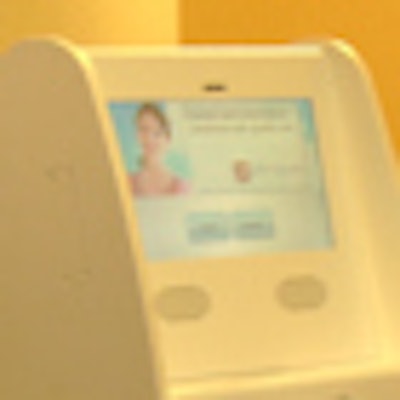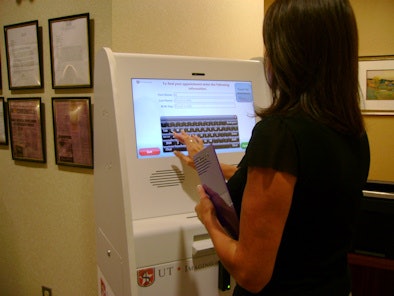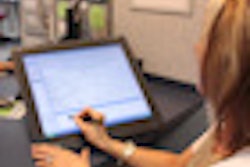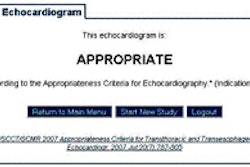
As imaging informatics tools steadily automate many functions of radiology departments and imaging centers, patient kiosks could become a front-office fixture. Hospital admissions and other departments have been early adopters, but radiology facilities are also starting to use kiosks to their workflow and financial advantage.
The key benefits are threefold: better management of patients' check-in process, especially in busy departments or at peak arrival times, increased accuracy of acquiring demographic and insurance information, and more effective collection of patient payments at the time of treatment. In an imaging center with a multilingual patient constituency, kiosks also can provide the function of serving as language translator and information provider.
AuntMinnie.com interviewed three radiology practices that installed patient kiosks in their imaging centers to learn what they contribute and if the investment was a good one. If their experiences are illustrative, kiosks may become a commonplace fixture. But one thing is certain -- they won't totally replace front-office reception staff.
Kiosks can be wall-mounted touchscreens, a touchscreen with an attached magnetic stripe card reader mounted on a slim pedestal, or countertop kiosks interfaced with document printers. Kiosks can also morph into handheld ruggedized tablet PCs, providing the same functionality with increased privacy. For healthcare facility applications, the cost of a kiosk ranges from a few thousand dollars to $100,000 or more for some types of sophisticated multifunction units used in hospitals.
Improved check-in
Radiology Ltd. of Tucson, AZ, with nine imaging centers located across southern Arizona, may have been the first radiology practice to utilize kiosks. The practice installed its first unit in 2006, with the objective of increasing check-in efficiency and workflow and improving patients' experiences at check-in, according to Eric Nied, information technology director.
In addition to eliminating patient front-desk check-in delays, the practice also wanted to eliminate as much copying, scanning, and receptionist completion of forms at registration and check-in as possible.
Before the kiosks were installed, check-in averaged seven minutes once a patient began to speak with a receptionist. Today, the process averages three minutes. Fewer customer-service staff members manage the front desks, but Nied said there has been no attrition attributed to increased kiosk efficiencies. Some staff members were moved to become roving kiosk assistants; others were transferred to different job responsibilities.
Radiology Ltd. spent several months analyzing their needs at each center. Managers evaluated the average number of patients per day, the waiting time for patients in queue to check in during peak arrival periods, the number of patients with scheduled appointments, the number of unscheduled walk-in patients, and the number of staff who worked with patient check-in, form completion, and insurance verification.
The practice chose to utilize a combination of desktop kiosks and ruggedized mobile PC tablets. It allowed ample time for staff to be trained and identified super-users at each center.
Registration time has been reduced by up to 50%. Patients who want to use kiosks are provided with an ID card to access the system. When a person swipes this card on a card reader on the MediKiosk (NCR, Duluth, GA), the device retrieves the patient's data from the radiology information system (Centricity RIS, GE Healthcare, Chalfont St. Giles, U.K.). Information is populated on the display, and the user enters, validates, and/or updates patient demographic and insurance information.
Nied said that the kiosks have the ability to collect co-pays at the kiosk, but the practice has chosen not to implement this feature because of workflow and other cost-saving efficiencies. Radiology Ltd. has a department dedicated to insurance verification, because it has found that this is more efficient due to patient variables.
UT Imaging, located in the suburb of Bellaire, TX, is a low-volume imaging center performing about 33,000 diagnostic imaging exams annually. The center agreed to beta-test an avatar-enabled, RIS-integrated kiosk (Merge Healthcare, Milwaukee) starting in November 2009. The experience has been so positive that the Olivia kiosk has become a permanent fixture.
"We have a busy front desk, and this was the primary reason that we were interested in trialing the kiosk," administrator Marilyn Lester said. "A complaint that patients make about the center is that we ask them to arrive early to complete paperwork, and yet they may wait in line to check in and receive it. We wanted to change this."
 |
| Patients have the option of using the kiosk for check-in at UT Imaging. Image courtesy of UT Imaging. |
"Our front desk staff was initially concerned that they might lose their jobs, but I made a point of repeatedly telling them that this wouldn't happen," Lester said. "We'd reallocate some of their work, and that, in fact, is what we have done. I told all of our staff that with reimbursement changes, we needed to increase our exam volumes by 20%, and we had to manage this increased workload with no additional staff. We're going to try this technology to see if it makes our work more efficient."
The staff agreed to the experiment and learned how to use not just one, but two beta versions of the kiosk.
Workflow
Utilization is strictly voluntary, but a lot of patients walk directly to the kiosk, which has both English and Spanish language versions. After selecting a language, patients enter their name and date of birth. This information is sent to the RIS, which displays the address, insurance information, appointment time, and type of exam scheduled. Paperwork specific to the procedure and the patient (such as a pregnancy waiver for women) is printed at the adjacent printer; the patient completes it and takes it to the front desk.
Patients without a scheduled appointment are identified at the beginning of the process, and they're asked if they have a script from their physician. If they do, they continue with the check-in and are placed in a "schedule patient" field in the RIS, and a "verify insurance" field is activated.
If they do not, they are requested by the kiosk to see a receptionist. UT Imaging does not perform any exams without receipt of a script from either the patient or the ordering physician.
The second generation of the kiosk, which was installed in January 2010, enables patients to make co-payments by exact-amount cash payments or with a credit/debit card. Patients have the choice of using the kiosk or making payments at the front desk.
What is unique about this kiosk is that patients can elect to talk with an avatar. When the avatar symbol is pushed, an employee located at the headquarters of Olivia Greets, a virtual global reception service with headquarters in Chicago, responds. A video camera inside the kiosk provides a view of the patient. The "avatar" offers to assist the patient, answering questions, or even taking over the controls to complete the various touchscreens.
Lester said that patients who "ring" for the avatar represent all ages of both sexes. If requested at the beginning of check-in after entering name and date of birth, the avatar's mouth will move as it starts with a script: "Hi, I see that you have an appointment for a (TYPE OF) exam at (TIME). Is this your address? Is this your insurance carrier and your identification number? Has anything changed?" The avatar will continue the speech, using whatever script combination is appropriate. Currently, only English-speaking avatars are available, but Olivia Greets plans to offer multilingual avatar service in the future.
|
Lester has been tracking kiosk utilization, which is on the rise. Monitoring utilization of the avatar is important, because Olivia Greets' customers purchase bundled minutes of use, just like cell phone service.
The trial at UT Imaging is the precursor for implementing the Olivia kiosk at other imaging centers owned by Outpatient Imaging Affiliates of Nashville, TN. As at Radiology Ltd., accuracy levels have risen dramatically, facilitating the entire process and reducing expenses relating to claims processing and the time to receive payment. Lester reports that a higher percentage of patient co-pays is also being collected at the time of service.
Efficient payment collector
To Insight Imaging, kiosks facilitate payments. This Lake Forest, CA-headquartered corporation of 65 imaging centers began to implement patient kiosks in 2008. From the outset, its objectives were to improve the patient check-in experience; reduce errors that inadvertently were being made and, in doing so, decrease first-level denials of reimbursement claims; and collect patient payments of outstanding deductibles and any amount that an insurance company will not cover for a procedure.
Patricia Blank, executive vice president of business process management at Insight Imaging, has discovered that kiosk payment integrated with an insurance verification service is an extraordinarily successful way to receive a portion, if not all, of patient collectables at time of service. Since 2008, this portion of revenue collection went from zero to $11 million. Increased patient satisfaction with expedient check-ins has just become icing on the cake.
The kiosks proved to be a means to an end. Insight Imaging contracted with Clearwave, an Atlanta-based vendor providing real-time online healthcare authentication with insurance providers through kiosks.
"I wasn't interested in kiosk technology by itself if the service couldn't interface with our proprietary RIS," Blank said. "I needed the kiosk vendor to accept patient demographics, scheduling, and order information, while returning 271 insurance data field values. Clearwave did this, providing far greater utility to the imaging centers than patient information entry of data via kiosk alone."
Kiosks were planned for every center, but Blank soon realized that they were not needed in centers with only one or two modalities. Patients are always scheduled for MRI and PET or PET/CT exams, and insurance authorization is obtained in advance. But the kiosks were invaluable in large-volume centers and centers with high percentages of walk-in patients.
"A patient always has the option to use the front-desk services instead of using a kiosk," she said. "When self-check-in is chosen, the patient is asked to swipe a card. Information to be validated is propagated on the display touchscreen for scheduled patients. Patients without scheduled appointments complete the information."
The greatest value of the system is Clearwave's ability to provide immediate insurance validation and also to identify if patients have met their insurance deductible. Insight Imaging has entered all of its contracts for each of its imaging centers, so the system provides immediate information about the percentage of procedure cost for which the patient is responsible. As an example, this might be 20% of a MRI examination with a contracted rate of $500.
When a patient is scheduled in the RIS for an exam, insurance information is simultaneously transferred to Clearwave. At the time of scheduling, insurance verification is made. When the patient arrives for the exam, insurance information is again confirmed, either through the kiosk or by a customer service representative, along with current information about outstanding deductibles.
"We don't collect co-pay visit and other patient-owed amounts, because it is not possible to know exact charges until the technologists have completed the exam," Blank said. "But after the procedure, when the patient is checking out, he or she will receive a bill for exactly what the charges are, the portion that the insurance company will pay, and the portion that the patient owes."
Direct credit card payment by kiosk has not yet been implemented. Patients still interact with a cashier, with most paying what they owe before they depart.
First-level denial rates have dropped from 15% to 5%, based on the system's ability to identify patient errors as well as front-desk clerical errors.
"It's easy to select the 'self' button or box when you are asked for the name of the insurance holder, but if this doesn't correlate with the RIS or the insurance provider, the error is caught immediately prior to claims submission," Blank said.
The percentage of patient payments collected at the time of the exam has skyrocketed, and Blank's objective is to achieve an 80% or higher level. The write-off of bad debt sent to collection agencies has dropped by 25%.
As for return on investment on the kiosk-based health verification service, Blank noted that it far exceeded anyone's expectations.
By Cynthia E. Keen
AuntMinnie.com staff writer
June 25, 2010
Related Reading
Merge debuts patient kiosk at HIMSS, March 1, 2010
MedCurrent tackles front end of insurance verification, April 6, 2009
Carestream to show new products at HIMSS show, January 26, 2009
Copyright © 2010 AuntMinnie.com



















